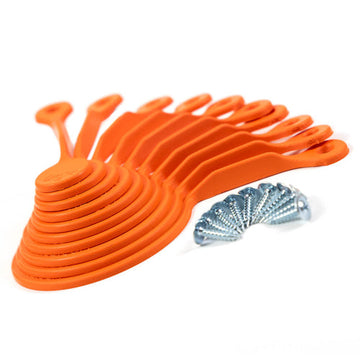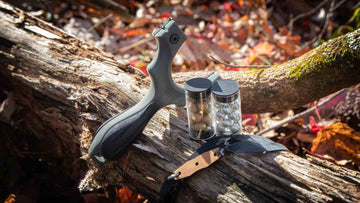Flat Bands vs Tubular Bands:
An In-depth Slingshot Band Comparison
When it comes to choosing between flat bands and tubular bands for slingshots, personal preference plays a key role. While tubular bands are familiar to many due to their use in wrist rockets, flat bands offer faster retraction and lighter weight. In terms of performance, flat bands tend to shoot faster compared to tubular bands. However, flat bands may wear out quicker, albeit with similar band life when stretched to their maximum elongation. On the other hand, flat bands allow for infinite customization by cutting tapers and matching them with ammo and draw length. Tubular bands, especially looped tubes, are popular for their power.
Ultimately, the choice between flat bands and tubular bands depends on individual preferences and experimentation. SimpleShot offers slingshots with flat bands as standard, while select models feature looped tubular bands. Both options have their merits, and trying them all is recommended for an enjoyable shooting experience.
Tubes vs Flats
Eight years ago, we posted this video. We don't post trick shots and the kind of videos that get loads of views, so for a video like this one to have almost 300,000 views says something. This is a question that many people have.
Watch the original video on tubes vs. flats here.
When it comes to choosing between flat bands and tubular bands for slingshots, beginners often wonder which option is better. The truth is, it all boils down to personal preference. Many people have prior experience with tubular bands on wrist rockets. However, when they switch to a slingshot with flat bands, they notice a significant difference. One of the main advantages of flat bands is their ability to retract rapidly. This is due to reduced internal friction and their lighter weight.
This unique feature makes them highly effective in various applications. Whether it's in fitness training, physical therapy, or even industrial settings, the quick retraction of sheet latex allows for efficient and dynamic movements. In industrial applications, flat latex enables smooth and precise movements, enhancing productivity and accuracy. With its impressive retraction capabilities, flat sheet latex is a versatile and valuable tool for a wide range of purposes.
To illustrate this point, let's consider two slingshots: one equipped with tubular bands and the other with flat bands. Assuming both slingshots have the same draw length and projectile and both have the same draw weight — let's say, 12 pounds — generally speaking, the setup with flat bands will achieve higher velocity compared to the one with tubular bands . . .
But here's where it gets good.
Flat latex bands are a game-changer in the world of slingshots because of their unique ability to maximize velocity even at a lower draw weight. Modern advanced latex allows shooters to experience an unprecedented level of efficiency and precision because it's not merely about raw power; it's about achieving that power effortlessly.
With flat bands, you get the unique advantage of high-speed performance without the burden of heavy draw weight. It's an incredible combination of lightweight handling and high-speed performance.
Real world example: our 5/16 bandsets require a mere 7 pounds draw weight when tuned to a 5X elongation, but will still chuck steel down range at a speedy 250 feet per second.
Speaking of draw weight . . .
⭐️ ⭐️ ⭐️ ⭐️ ⭐️
Very fast and accurate using the Scout and the clay bands. It is fun to rip apart tin cans with the clay ammo.
– Kevin A.
Let's put a myth of draw weight to rest once and for all!
First things first, let's talk about how slingshot latex works. It's a simple yet powerful tool that harnesses the potential energy stored in its bands. When you pull back on the bands, you're loading them with energy. The release sends your projectile soaring through the air with incredible force and precision when the system is tuned properly.
The velocity in a slingshot shot is primarily derived from the potential energy stored in the stretched bands. When the bands are pulled back, they store energy equivalent to the amount of work done in stretching them. Upon release, this energy is quickly converted into kinetic energy, propelling the ammunition forward at high speed. The velocity of the shot is influenced by various factors such as the elasticity (retraction) of the bands, the extent to which they are stretched (elongation), and the weight (mass) of the ammunition. Lighter ammunition will generally travel at higher velocities, while heavier ammunition may hit harder but travel slower. Because there's only so much energy in the bands, right?
Did you notice what is NOT in that equation?
Right. Draw weight.
Now, draw weight is a term commonly associated with bows and crossbows. It refers to the amount of force required to pull the string back to its full extent. The harder you pull back, the harder the bow string returns and shoots the arrow.
But guess what? Slingshots are a whole different ball game!
When it comes to slingshots, the draw weight doesn't matter anywhere near as much when choosing the right bands for hunting or target shooting or for determining how fast your slingshot will shoot.
Why?
Because the power behind a slingshot shot doesn't come from the draw weight, but from the retraction of the elastic.
Let's break down the factors involved.
Ammunition Weight: Different types of projectiles have varying weights, from lightweight steel balls or clay ammo to heavier ball bearings or marbles. The weight of your ammunition greatly affects the force and trajectory of your shot. The heavier the ammo, the more energy it needs to go flying toward the target.
Band Materials: The market offers a variety of slingshot band materials, each with its own unique properties. From natural latex to high-performance synthetic options, you can choose bands that suit your shooting style. The type of material determines the stretchiness, durability, and overall performance of the bands.
This brings us back to the topic a hand, but we're not there yet. Let's finish out this idea of draw weight.
Draw weight is a measurement of how much force it takes to draw the band.
Retraction is a quality/ability of the latex and is not directly related to the weight of the draw. Some elastic retracts very quickly; some does not. This is noticeable in an everyday object such as a rubber band. Some rubber bands are very stretchy and really snap when you stretch and release one. Others are more "gummy" and stretch, but don't pop. The one that snaps back has high retraction, the other does not.
All latex is not created equal.
If you've ever shot a Walmart-style wrist rocket, you've experienced this. These slingshots have a very heavy draw weight, but these elastics are designed to sit on the shelf of a store for a couple years, not to retract with great speed. So what you get with one of these wrist rocket style slingshots is latex that will last a very long time, but has very poor retraction.
Conclusion:
• Heavy draw does NOT equal high velocity in the world of slingshots.
• The ability of the band to retract quickly DOES equal high velocity.
• The best latex retracts quickly with a low draw weight.
Learn all about this topic and more in these videos:
Nathan addresses the draw weight myth here:

Another question about draw weight and elongation:

4 years ago, we discontinued double bands. Why? Watch and see.

Shooting the slingshot canon to demonstrate band tuning and retraction!

So back to the topic of whether flat bands or tubes are better.
When it comes to slingshot, elastics, flat band latex outperforms tubes any day of the week. You just can't beat the retraction rate of modern slingshot elastics. It draws smoothly and retracts quickly for the best shooting experience, in our opinion.
Let's talk about longevity. Do tubes or flats last longer?
When it comes to longevity, the debate between tubular bands and flat bands is sometimes contentious. Generally, tubular bands are perceived to last longer due to their thicker construction and lesser surface area exposed to atmospheric conditions that might cause wear and tear. However, it's important to note that the lifespan of slingshot bands, whether flat or tubular, is affected by some factors beyond the physical resiliency of the band. Regular use, exposure to sunlight or ozone, and contact with chemicals that degrade latex (such as hydrocarbons such as oil) affect the bands' lifespan significantly. So while tubes might have an edge in terms of longevity, proper care and handling can significantly extend the life of flat bands as well.
We're not going to debate whether tubes last longer than flats because there are so many factors here. Tubes do seem to have the edge I'n brute strength. They seem to take a beating better than flats. A bit of abuse that might put a hole in a flat might not puncture a tube because the walls of tubes are simply hands down thicker than most flats.
All bands wear out. No matter if they are tube bands or flat bands, they all have an expiration date. It is a universal truth that no band can last indefinitely, as they inevitably succumb to the effects of wear and tear. However, while their lifespan may be limited, the memories and impact they create can last a lifetime.
Customization. Do flats or tubes offer more options?
This one is easy. Flat bands provide you with the opportunity for limitless customization by cutting your own tapers and matching the band's taper, the ammunition, and your draw length, resulting in a truly bespoke band set. Conversely, with a tubular band, especially those found in big box stores, this level of personalization is lacking. All you can do is adjust the length of the bands. You can make your own tub bandsets with some customization, but there's no doubt: if you want truly custom bandsets, flat bands are the way to go.
In the end, flat bands are simply more versatile and customizable than tubes. They offer a wide range of options that can be tailored to your specific needs and preferences.
Let's recap and answer the question of whether flats or tubes are better . . .
- In the world of slingshots, it's crucial to understand that draw weight, a term borrowed from archery, does not directly influence the power or velocity of a shot. Instead, this is determined by the retraction of the band material, which varies according to the specific properties of the latex used.
- Slingshot band materials come in various forms, from natural latex to synthetic options, each influencing the stretchiness, durability, and overall performance of the bands. (Tip: don't bother with anything but modern slingshot latex.) A direct comparison can be drawn between this and common rubber bands - some are highly stretchable and snap back quickly upon release, while others are more gummy and lack the same retraction speed. Not all latex is suitable for slingshot shooting and some is far better than the rest.
- Using low-quality slingshot bands such as those found on a wrist rocket exemplifies this. Although these possess a heavy draw weight, the bands are designed for long shelf life rather than high-speed retraction. The end result is a durable but low-performance slingshot band.
- Flat bands are superior to tubular bands for slingshot elastics due to their superior retraction rate. However, when it comes to durability, tubular bands often win due to their thicker construction and less exposure to wear and tear. Regardless of the band type, all bands will eventually degrade and fail, influenced by usage, exposure to sunlight, ozone, and contact with latex-degrading substances such as hydrocarbons.
- Customization is also where flat bands truly shine. They allow limitless personalization through adjusting tapers to match the band, ammunition, and user's draw length, leading to a truly tailored band set. Tubular bands, on the other hand, offer fewer customization options.
In summary, it's the retraction capacity and properties of the band material, not the draw weight, that determines the power of slingshot shots. When choosing between flat and tubular bands, flat bands offer superior performance and customization options, while tubular bands may last longer. However, proper care and use can significantly extend the lifespan of any band, ensuring continuous and enjoyable slingshot shooting sessions.
So again, which should you choose, flat band or tubular slingshot bands? It's really up to you. Try them all. Most of the slingshots that you'll purchase at Simple Shot come with a flat band for the reasons given above. They shoot fast with a low draw weight. And if you are making your own bands, the possibilities are endless with flat sheet latex bands.
Conclusion: Flat bands win.
In almost every category, flat bands are your best bet.
Velocity: Flat bands
Velocity per pound of draw weight: Flat bands
Durability: Tubes
Customization: Flat bands










